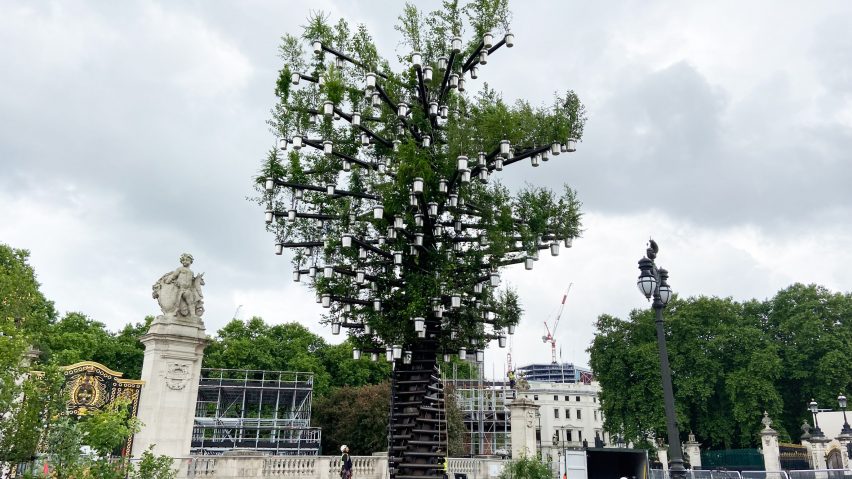This week on Dezeen, we published the first images of Thomas Heatherwick's Tree of Trees, a sculpture containing 350 living trees that was designed to celebrate the Queen's Platinum Jubilee.
Officially set to be unveiled on 2 June as part of the Queen's Platinum Jubilee weekend celebrations, the Heatherwick Studio-designed sculpture outside London's Buckingham Palace was completed on Tuesday.
Dezeen revealed the first images of the 21-metre-high structure, which was erected to draw attention to a tree-planting campaign created to mark the Queen's 70 years on the throne.
We continued our series on deconstructivism with an interview with architect Bernard Tschumi who argued that the architecture style was built on a desire for exploration that contemporary architects do not share.
"When you asked me what was deconstructivism's impact on contemporary architecture – that's where I want to retreat at the back of the room," he told Dezeen.
"So many corporate firms have literally learned too much, but purely about the image-making part of the deconstructive period."
Also as part of the series, we shone a light on the work of late British-Iraqi architect Zaha Hadid, who designed buildings such as the Heydar Aliyev Centre, which earned her the nickname "queen of the curve".
In Norway, architecture firm BIG completed a mass-timber Passivhaus factory for outdoor furniture manufacturer Vestre, which the brand has hailed as "the world's most environmentally-friendly furniture factory".
The cross-shaped building is concealed in a forest and stores 1,400 tons of carbon dioxide in its mostly-wooden structure.
Architecture studio De Matos Ryan designed a pyramidal "treeless treehouse" for a London garden that can only be accessed by crawling underneath it.
The structure caused a stir as readers reacted to it in our latest Dezeen Debate newsletter.
Pritzker Prize-winning Portuguese architect Álvaro Siza also made headlines by completing his first building in the United States – a limestone-clad skyscraper in Manhattan.
The 611 West 56th Street skyscraper is a 450-foot-tall (137-metre) residential tower that Siza previously likened to the form of a giraffe's long neck in a Dezeen interview.
This week's design projects include an open-source machine by industrial designer Reiten Cheng that can recycle PET bottles into 3D-printing filament.
Meanwhile, food and beverage company Kirin Holdings collaborated with researchers at Meiji University to design Taste-Adjusting Chopsticks, a wearable device that intends to make food taste saltier using only an electric current.
Dutch designer Marcel Wanders also announced his decision to indefinitely suspend operations at his eponymous studio and focus on a series of smaller projects instead.
"I have been feeling a sense of dissatisfaction and an urgency inside myself to change something in my creative life and process," said the designer.
"I'm not abandoning the design world," he added. "I will still create. I will just create less."
In UK news, London's much-anticipated extension to its underground railway opened to the public on Tuesday.
To mark the unveiling of the Elizabeth Line, we rounded up 10 metro stations from across the globe that have been updated in recent years.
Popular projects this week include a "neo-brutalist" concrete house in Ahmedabad by The Grid Architects and an Ecuadorian micro-apartment by Juan Alberto Andrade and María José Váscones that makes the most of its limited space.
Our most recent lookbooks showcased homes with water features and residential open-plan studies.
This week on Dezeen
This week on Dezeen is our regular roundup of the week's top news stories. Subscribe to our newsletters to be sure you don't miss anything.

